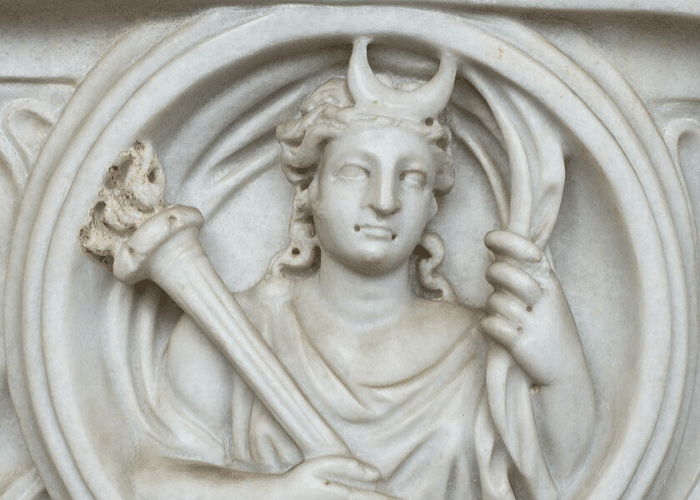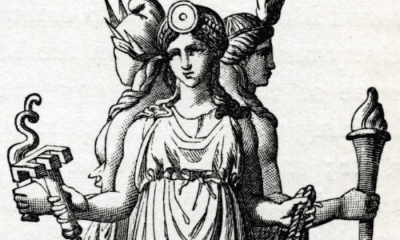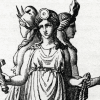
Greek
Selene: The Goddess of the Moon
Selene: The Goddess of the Moon
If you thought Artemis was the Greek goddess of the moon, you are only partially right. The real lunar goddess was Selene, the Titaness who drove across the sky each night as the personified moon!
The Greeks recognized several goddesses as having a connection to the moon, but none was as closely associated with it as Selene.
Selene was more than just a lunar goddess, she was the embodiment of the moon and its light.
While we often think little of the moon today, in the ancient Greek world the moon’s cyclical movement through the sky played a central role in their concept of time. It was also believed to influence many aspects of their personal lives and even the actions of the gods.
Modern audiences do not often think about Selene’s cyclical nature, however. The most enduring story of Selene concerns the love she felt for an ordinary human man.
If you’ve ever wondered what role the moon played in ancient life, here is your chance to learn about how the Greeks viewed Selene, the personification of the moon.
Selene and Her Siblings
Selene was one of the three children of Hyperion and Theia, two of the original twelve Titans.
Her father was the Titan god of heavenly light, while her mother represented the blue color of the sky. Together, they fittingly created three sources of celestial illumination.
Their daughter Eos was the first to appear each day. She was the goddess of the dawn and brought new light to the world every morning.
Eos represented the warm light that could be seen coming up above the horizon before the sun appeared in full. She announced the coming of her younger brother.
Helios, the son of Hyperion and Theia, was their second child. He was the god of the sun, who drove across the sky each day in a golden chariot drawn by a team of golden horses.
At night he drove below the edge of the world in the west, circling below Gaia to reappear on the eastern horizon by morning.
Selene, the goddess of the moon, was the youngest of the three siblings. The counterpart to her brother, she traveled by night.
The Chariot of the Moon
Like Helios with the sun, Selene drove the moon across the sky each night in a chariot.
While her husband’s team of horses usually consisted of four animals, Selene’s chariot, like her light, was less powerful. Two winged steeds pulled her across the sky each night.
Occasionally Selene’s chariot was pulled by oxen or bulls, again differentiating it from the faster vehicle of her brother. The animals, however, were almost always shown as pure white regardless of their type.
Selene herself most often wore a crown of gleaming silver, which matched her silver chariot. While her brother was clad in shining gold, her light was softer and more clear.
Her appearance matched the night sky she drove through. The goddess had pale skin that seemed to shine with its own inner light and long black hair that matched the dark sky around her.
Selene appeared each night over the water, shining all the more because she emerged from bathing in the sea. But on nights the moon could not be seen, there was a very good reason for her absence.
Selene’s Great Love
The moon goddess was said to have had several lovers, including Zeus and the wild god Pan. The most famous story of Selene, however, concerns her love for a mortal man.
Endymion was, depending on the source, a prince in exile or a simple shepherd. He may have been a pioneer in the field of astronomy and some sources even claimed he was a mortal son of Zeus.
Whatever his profession, the handsome young man frequently slept beneath the open sky. Selene saw him as she passed overhead and fell deeply in love.
Selene was so enamored of the young man that she left the sky to see him more closely. She walked as quietly as possible to avoid frightening Endymion as he slept.
She began to do this every night, leaving her chariot behind and making the sky dark with her absence. Occasionally she asked her brother to take over her duties so she could spend more time on the ground with Endymion.
It did not take long for Zeus to notice something was amiss. The sky was dark at night and the sun more lethargic than usual.
He soon discovered the source of Selene’s distraction. Although Zeus had taken many mortal lovers, the goddess of the moon had been abandoning her duties and could cause chaos if she continued.
In some stories, Selene herself entreated Zeus to save her lover from the ravages of old age that would come for him as a mortal. Zeus put Endymion into an eternal sleep so the goddess could see him forever as a beautiful young man.
Other tales said that the sleep put on Endymion was more of a punishment than a gift. Zeus had enough sympathy for Selene to not kill Endymion outright, but he put the human man in an enchanted sleep on Mount Latmus in the East so Selene would have no further reason to descend to earth each night.
A third version of the story had Endymion himself choose an ageless sleep as opposed to living a mortal life. Even if he were sleeping, he would not be parted from the goddess he loved by death.
Selene could still see her sleeping love whenever she pleased, but the pressures of time and mortality were taken off her. Knowing he would be there whenever she wanted to see him, the goddess no longer worried he would leave or die before she got to see him again.
The cave in Anatolia where Endymion was said to sleep became a holy place for Selene. Watched over by nymphs and visited often by the goddess, it was marked by glowing moonstones and pure white rock.
That haunted cave [on Mount Latmos] of fair-haired Nymphai (Nymphs) where, as Endymion slept beside his kine, divine Selene watched him from on high, and slid from heaven to earth; for passionate love drew down the immortal stainless queen of night. And a memorial of her couch abides still ‘neath the oaks; for mid the copses round was poured out milk of kine; and still do men marvelling behold its whiteness. Thou wouldst say far off that this was milk indeed, which is a well-spring of white water: if thou draw a little nigher, lo, the stream is fringed as though with ice, for white stone rims it round.
-Quintus Smyrnaeus, Fall of Troy 10. 127 ff (trans. Way)
Although Endymion slept for eternity, many sources said Selene continued to see him. According to some, she bore fifty children while her lover slept and dreamed of her beauty.
Whenever the moon could not be seen in the night sky, it was because Selene had paused to take in Endymion’s beauty once again. Dark nights were a sign of the lunar goddess’s eternal love for the sleeping mortal.
The Lunar Goddesses
Selene was not the only goddess the Greeks associated with the moon. In fact, there were several female deities who shared this domain.
She was unique, however, in her relationship with the orb itself. While other goddesses were associated with the night in more general terms, Selene was believed to be the embodiment of the moon herself.
She and her brother did not just pull the chariots of their respective orbs through the sky. The light that humans saw from earth emanate from them, a legacy of their lustrous father.
There were still several goddesses who shared Selene’s lunar domain, however. They included:
- Artemis – The goddess of the hunt was also a deity of the moon, just as her twin brother was representative of the sun. The two were often conflated with Selene and Helios but had separate mythologies and characterizations.
- Hecate – The chthonic goddess of witchcraft and magic was also a lunar goddess. Witches were sometimes said to influence the moon, making it disappear or grow brighter to create the right conditions for casting spells.
- Pandia – Usually said to be the daughter of Selene and Zeus, Pandia was also sometimes given as another name for Selene herself. She was said to represent the full moon.
- Mene – The personification of the months was sometimes an aspect of Selene and sometimes a separate goddess. Mene was the Greek word for moon, but the Greek calendar was based on lunar cycles.
- Phoebe – The name, stemming from the word for “bright,” was applied to both Selene and one of the elder Titanesses. The masculine form, Phoebus, was used in reference to either Apollo or Helios as solar gods.
- The Moirai – In some traditions the Fates were seen as three aspects of the lunar goddess. The crescent moon, full moon, and dark moon corresponded to the three states of being embodied by the Fates.
The lunar goddesses sometimes worked together.
Hecate and her followers, for example, asked Selene for her cooperation in their magic. The moon goddess and Artemis were occasionally shown as companions.
Selene and the Division of Time
One of the names given for Selene, and occasionally for an independent personification, was Mene. The Greek word for the moon was also the word used to delineate the months.
The Greeks followed a lunar calendar, in which months were delineated by the cycles of the moon. Greek months began with the first new moon and were organized into three ten-day weeks that roughly followed the progression of the lunar cycle.
Festivals and feasts were determined by the lunar calendar, giving Selene as Mene an important role in the worship of all the gods and goddesses.
As the goddess of the division of the months, Selene was a goddess of time. She was often said to be the mother of the Horai, the personifications of the division of time and the seasons.
The months had their own personifications as well, who were all born from Selene. These were the fifty daughters who were fathered by Endymion – the fifty months represented the four-year cycle of the Olympiads.
The concept of Selene as the lunar goddess also made her an important goddess of childbirth and female fertility. A woman’s fertility was said to be influenced by the cycles of the moon, a belief that gave English the word “menses,” and under Selene’s influence women were said to have an easier time in childbirth than they did during the day.
The Goddess of Lunacy
The moon was thought to influence people in other ways, as well. Lunacy takes its name from Selene’s Roman counterpart, Luna.
Certain types of insanity were said to be brought on by the moon’s influence, and it was believed that Selene had the power to create lunacy with purpose.
In this aspect she was closely associated with Dionysus. His rites also brought a form of madness about in his followers, who often celebrated under the light of the moon.
While the Maenids of Dionysus were driven mad by the frenzy of their worship, however, the madness brought about by Selene could be used as a targeted punishment. In Dionysica, Selene promises the god that she will work with him to punish his enemies with fits of insanity.
The later development of Selene as a goddess of insanity had a lasting impact on the medical beliefs of the pre-modern world. For centuries, those affected by mental illness were referred to as “lunatics.”
Selene the Moon Goddess
The Titaness Selene was one of three siblings who brought light to the sky. Her sister Eos was the light of dawn and their brother Helios drew the chariot of the sun across the sky each day.
Selene was the goddess of the moon. Her chariot was made of shining silver, bringing soft, clear light each night.
While there were many goddesses associated with the moon and lunar powers, Selene personified the moon and its light.
The most well-known story of Selene is her love of the mortal man Endymion. Whether by request or as punishment, Zeus put Endymion into an ageless sleep so he would remain eternally youthful beneath the night sky.
The Greeks followed a lunar calendar, making Selene one of the most important deities in the passage of time. Her fifty daughters with Endymion marked the fifty lunar months that passed between celebrations of the Olympiad.
The lunar goddess was also important for her influence over female fertility cycles and childbirth. In later eras, she became associated with madness as well.
Selene is often eclipsed by the popularity of Artemis as a lunar goddess, but as the personification of the moon itself she had a significant impact on the lives and views of the Greek people.




